Develop an effective DEI communications strategy with our 7-step guide. Align DEI efforts with business goals and foster an inclusive, equitable workplace.

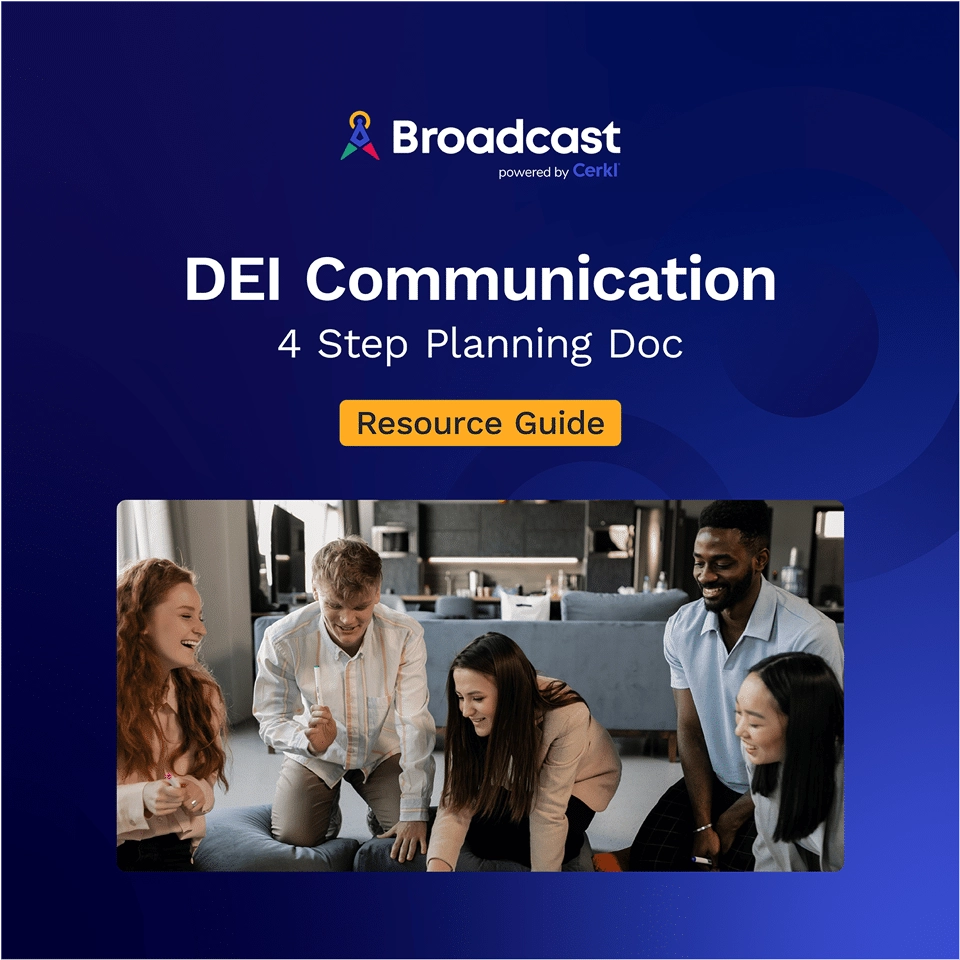
Communications around Diversity, Equity, and Inclusion (DEI) need to be strategic, thoughtful, and empathetic. Ensure your DEI communications are up to standards with our 4 step planning document.
Access Now
Effective communication is essential for any organization, but its importance is magnified when applied to initiatives involving diversity, equity, and inclusion (DEI).
While many organizations have embraced DEI efforts, research from McKinsey’s The State of Organizations 2023 survey reveals a significant gap between DEI aspirations and tangible progress. Although 70% of CEOs report having ambitious DEI goals, 47% admit they lack the infrastructure to achieve them. Nearly half state that their organizations have focused on strengthening their leadership DEI efforts. However, only 43% say meaningful action has been taken to address workplace discrimination and bias within their organizations.
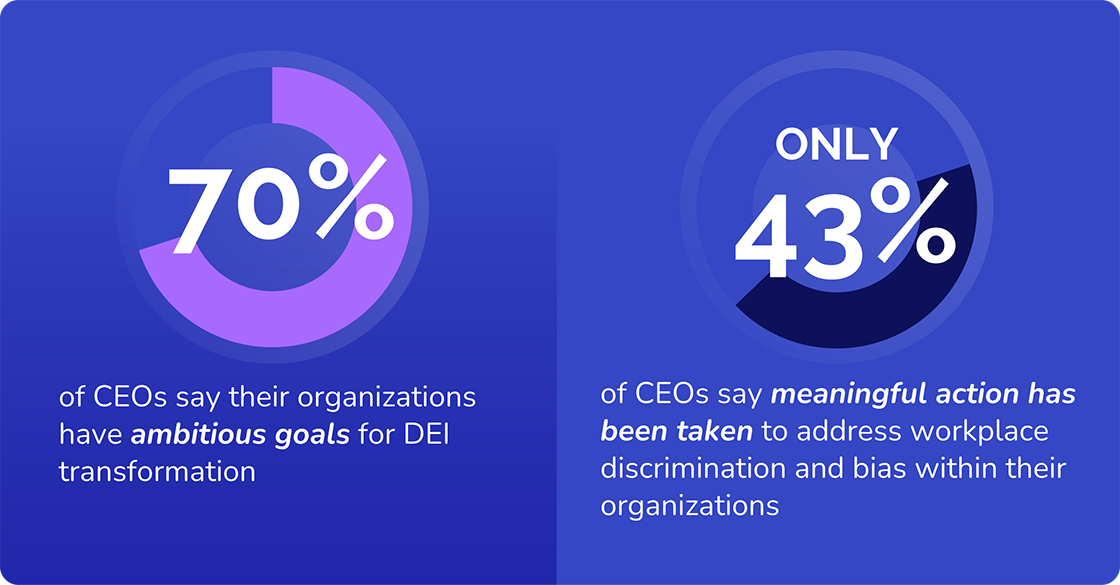
A critical reason for this gap is the disconnect between DEI strategy and broader corporate goals. McKinsey emphasizes that leaders must take a more systematic, aligned approach to ensure DEI initiatives create real impact. For example, they need to take the goals and intended impact of their initiatives into account. This requires not only identifying internal opportunities but also considering the organization’s influence on the broader community and society.
We are going to explore DEI and the concept of communication as it relates to DEI and suggest strategies for building effective DEI communication practices. Our 7-step guide explores how communication plays a pivotal role in DEI. It also provides a winning strategy to help you develop effective DEI communications. Additionally, we offer a comprehensive checklist to ensure that every aspect of your DEI communications is thoughtfully addressed, enabling your organization to foster a diverse, equitable, inclusive environment for all.
Diversity, equality, and inclusion (DEI) has increasingly become a critical aspect in organizations. For the uninitiated, DEI refers to the conscious practice of fostering an environment that celebrates differences, treats everyone equally, and includes all individuals, regardless of their backgrounds. Be it gender, race, culture, or personality type - every difference is valued and respected in a DEI-embracing workspace.
More simply stated, it strives to meet the needs of employees from all walks of life.
Job seekers today pay a significant amount of attention to whether or not their prospective employers maintain a healthy DEI environment. DEI also impacts the employee experience (EX) and influences the general image of an organization. Moreover, these initiatives don’t stop at creating a diverse workforce. They ensure that all employees are equally heard, respected, and provided equal opportunities. Furthermore, as countless studies have shown, organizations that embrace the values of diversity, equity, and inclusion become stronger. They are better equipped to respond to challenges, attract and win top employee talent, and meet the needs of a broader customer base.
Ensure your company's communications promote diversity, equity, and inclusion

Research published by Statista in 2023 highlights the most important outcomes of DEI programs for full-time employees globally. For 66% of respondents, creating inclusion and a sense of belonging was the most cherished result of DEI programs at their place of employment. Fair compensation was considered just about as important (65%). Using input from a diverse selection of employees to create improved strategies was tops for 60%. So, too, was recruiting and supporting the growth of a diverse group of employees. Only 58% thought it was important to have diverse decision-makers.
DEI is not just a social investment practice. It has a direct impact on an organization’s success. Countless studies show there is a correlation between diversity and business performance, extending to the bottom line.
Certainly, organizations that value DEI tend to be more innovative and outperform their competitors.
Here are two examples of what studies have found.
The Washington-based Pew Research Center conducted a national survey of 5,902 U.S. workers in February 2023. The majority (56%) said that focusing on increasing DEI at work is a good thing. This percentage is higher for women, with 61% saying it’s a good thing.
Some other interesting facts and findings that came from the survey include:
McKinsey has produced many reports that focus on DEI or that include commentary on DEI. One of these, Diversity matters even more: The case for holistic impact, released in December 2023, shows that:
In its previous Diversity Wins report published in 2020, McKinsey pointed out that “Progress in building diverse workforces remains stubbornly slow.” Three years later, their projections are more positive. “Despite a challenging business environment, the business case for diverse leadership teams is clear and growing stronger.”
DEI communications is an integral part of a company's DEI initiatives. In essence, it refers to effectively conveying DEI-related information both internally and externally. A good DEI communication strategy involves candid discussions on DEI topics, transparent reporting of the organization's DEI efforts, and promotion of DEI initiatives through various channels.These may include email, social media, internal newsletters, and town halls.
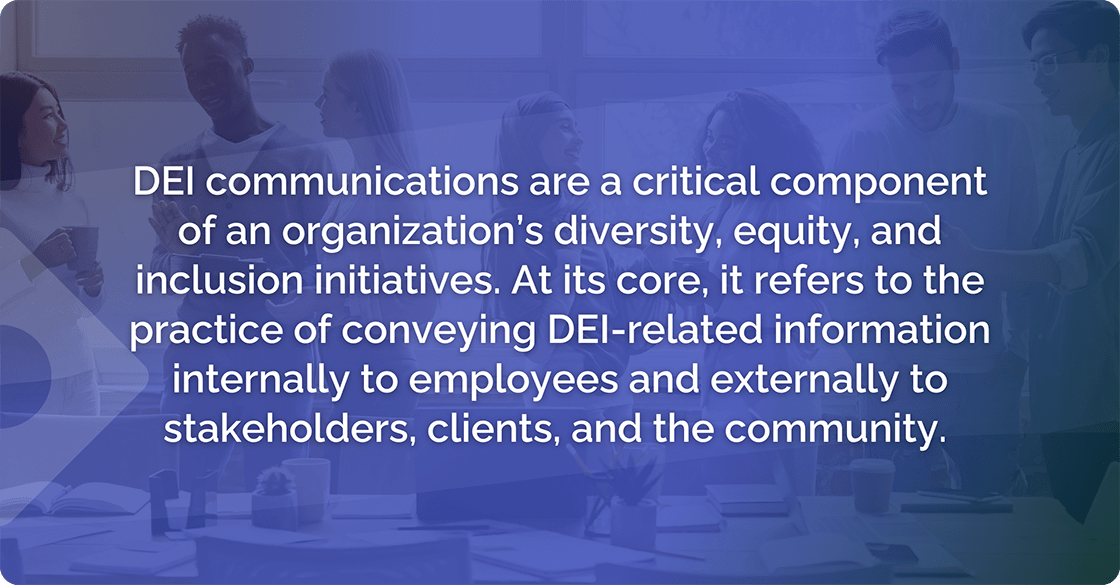
For example, executive leadership might send monthly emails providing diversity statistics and regular updates on progress made toward DEI goals. The human resources team may host webinars on critically important topics like inclusive language and unconscious bias, providing tips on how best to counteract them.
Additionally, a good DEI communication strategy tailors its messaging to the specific needs and nuances of its audience. For example, in healthcare, DEI communications might focus on culturally sensitive patient care and promoting diversity in medical staff, whereas in construction, the focus might be on promoting inclusivity in a male-dominated industry and ensuring fair representation at all levels.
By aligning DEI communications with an organization's broader DEI strategy, companies can create a culture of openness, inclusivity, and accountability, making sure that DEI efforts are visible and impactful both inside and outside the organization.
WebMD Health Services’ survey, Diversity, Equity, Inclusion & Belonging (DEI&B), reports that 62% of workers surveyed say DEI&B programs are ineffective. Nearly half (46%) believe they have personally failed them.
Ultimately, they found that employees in general live in a stressful world and they need more support from their employers.
One of the primary barriers to DEI communication is the lack of awareness or understanding of DEI itself. It can be challenging to have candid discussions about DEI when people do not understand its importance, which is why education is the first step in any successful DEI communication strategy.
Also, there’s no denying that forming an inclusive internal communication loop is not an easy task. There may be implicit biases and prejudices among employees that can unintentionally exclude certain individuals or groups. The fear of miscommunication or backlash can also discourage open DEI discussions
Ensure your company's communications promote diversity, equity, and inclusion

To build an effective communication strategy, you need to understand who you’re dealing with. You need to create a clear DEI-orientated message. Then, to spread your message, you need to choose the best possible communication channels to meet the needs of individual employees.
One essential aspect when constructing any communication strategy is understanding your audience. Unsurprisingly, it’s the same for an effective DEI communication strategy. Understand who your employees are, what they value, their preferred mode of communication, and the kind of DEI content that might interest them. An employee experience strategy lead plays a crucial role in gathering this valuable information. This person takes responsibility for developing the organization’s strategy to enhance and optimize the overall experience of its employees.
Surveys can also be very useful because they will give you an indication of what employees are thinking about DEI. They encourage input from employees, which in itself increases inclusion.
Creating a clear DEI message goes beyond just using inclusive language. It requires creating an environment where sensitive topics related to DEI can be discussed openly. Listening is just as critical as speaking. Encouraging employee advocacy by creating safe spaces for discussions can significantly help mold a favorable organizational culture.
A clear DEI message must also align with the organization’s core values and long-term goals. It should convey commitment, actionable steps, and accountability, ensuring that all stakeholders understand the company’s dedication to fostering diversity, equity, and inclusion in every aspect of its operations.
It is more important than ever to understand that each employee may have a different preferred communication channel. Some people might prefer emails, whereas others might respond better to more interactive modes like webinars or town hall meetings. Personal meet-ups, newsletters, intranet portals, and even social media can be leveraged to improve DEI communication efforts.
You should choose the appropriate generic channel based on your workforce demographic and their preferences. A platform that allows you the freedom to do this by targeting individuals and linking them to channels is the best option.
Inclusive internal communication is crucial for driving a vibrant DEI culture within an organization. It creates a respectful work environment where diverse perspectives are valued. It also promotes fairness and offers an employee experience that motivates employees to contribute to their maximum potential.
Fostering inclusive internal communications ensures that all employees feel heard, respected, and supported regardless of their background or role. This involves using accessible language, offering multiple channels for feedback, and ensuring that communication flows both ways. By making sure everyone’s voice can be heard, organizations promote trust and collaboration, which are both essential for sustaining a thriving DEI culture.
Inclusive DEI communications start from the top. Your executive leadership should lead by example, using inclusive language and demonstrating behaviors that value diversity. Ensuring that your EX strategy lead guides and fosters this culture can be a game-changer for any organization.
Another important factor is the appropriate training of internal communicators. They should be equipped with the skills to handle the nuances of DEI content and ensure it is communicated in a way that honors the diversity within your organization.
Adopting a zero-tolerance policy against any form of discrimination and promoting candid discussions on DEI issues can significantly boost your DEI effort.
An inclusive organizational culture is one where every individual feels valued, heard, and appreciated. Building such a culture requires conscious efforts to foster diversity, inclusion, and equity. This should be well-documented in your DEI communications strategy. Regular presentations, workshops, and team-building activities promoting inclusivity can radically transform your workplace culture.
Bridging the gap between various cultural and social backgrounds should be seen as an opportunity to learn and grow rather than a mere challenge. Regularly sharing stories, experiences, and lessons learned from different cultural and social backgrounds can foster understanding and acceptance among employees.
A diverse workforce brings a wealth of experiences, ideas, and skills to the table. Recognizing and appreciating this diversity through consistent DEI initiatives is crucial. Leveraging a diverse workforce can lead to innovation, improved problem-solving, and better performance overall.

It’s equally important to ensure that the diverse experiences and expertise are evenly represented across all levels and departments of the organization. This can be encouraged through a DEI communication strategy that includes programs for mentoring and sponsoring diverse talent.
The very essence of leveraging a diverse workforce lies in the organization’s ability to provide equal opportunities while embracing diversity and inclusive growth. Encouraging employees to share their success stories and discussing achievements during meetings or through digital platforms can be a great way to foster an inclusive work environment.
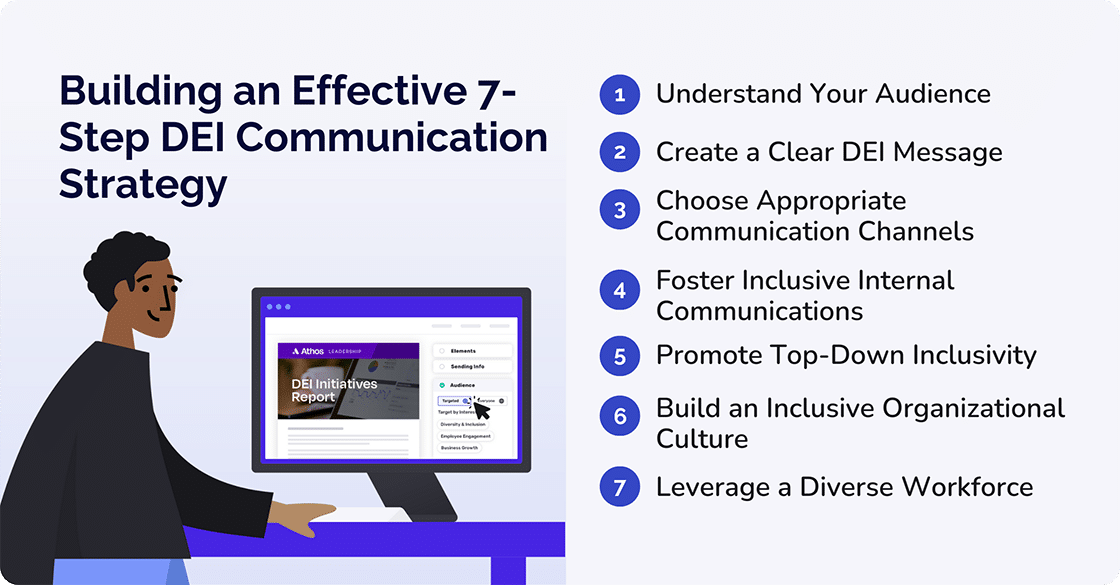
Effectively managing DEI communications requires a well-planned strategy. Checklists can be a useful component of this. They allow you to ensure that no crucial elements are overlooked in your DEI comms strategy.
Checklists also serve as a roadmap for internal communicators, ensuring nothing is missed during the implementation of DEI initiatives. The lessons learned throughout the process can be included in the checklist for continuous improvement. They allow for easy documentation of completed tasks and unaddressed areas needing attention. This contributes to transparency and allows for continual improvement in your communications efforts.
Some key items that your DEI communications checklist should include are specified awareness days, a reviewed inclusive language guide, clear routes for candid discussions, social media content checks, employee experience surveys, and inclusive hiring and promotional practices. These elements should be ingrained in your overall DEI communications strategy.
The fact that you need to engage both internal and external communication channels should be entered on your checklist too.
Ensure you have regular updates and engagements aligned with thematic days such as International Women’s Day, Pride Month, or Black History Month to highlight your commitment to DEI.
Your DEI communications checklist should also include a strategy for consistent internal training programs to educate employees on unconscious bias, cultural awareness, and inclusive behaviors. Regularly reviewing your inclusive hiring and promotion processes is essential to ensure they align with DEI goals. Another key item is ensuring that your leadership team is actively involved in modeling inclusive behaviors and regularly communicating DEI priorities.
Additionally, incorporating metrics and tracking mechanisms to measure the success of DEI initiatives, such as engagement rates in DEI programs or improvements in employee sentiment from surveys, will help gauge the impact of your efforts. By embedding these elements into your checklist, you can create a dynamic, results-oriented approach that drives meaningful progress.
To ensure the maximum efficacy of the checklist, it should be treated as a living document that evolves based on lessons learned, feedback received, and changes in organizational culture.
Here’s a FREE DEI Communications Checklist that you can use to prepare a communication plan for a DEI communication strategy.
The importance of communication is paramount in any DEI initiative, but it’s important to choose a platform that helps you get to the right people with the right information at the right time. It is also vital to ensure that internal communications are targeted to employees, taking all aspects into account. These should include DEI criteria, status and position in the organization, age group, and specified interests. This is the best way to ensure equity. Cerkl Broadcast enables you to do exactly this by using HRIS data and creating relevant segments.
Importantly, Broadcast is designed to meet the needs of organizations that want to communicate and engage with their employees and fully understand them. The platform ensures comms reach employees without getting ignored or lost.
The way it works is that comms are sent from a central content hub to all channels. When an employee opens the channel they prefer, Broadcast responds dynamically by removing the communication from that employee’s other channels. So there’s no repetition, and employees get to decide which channel to use at any given time.
A successful DEI strategy hinges on effective, streamlined communication. Cerkl Broadcast has the solution. Want to learn more?
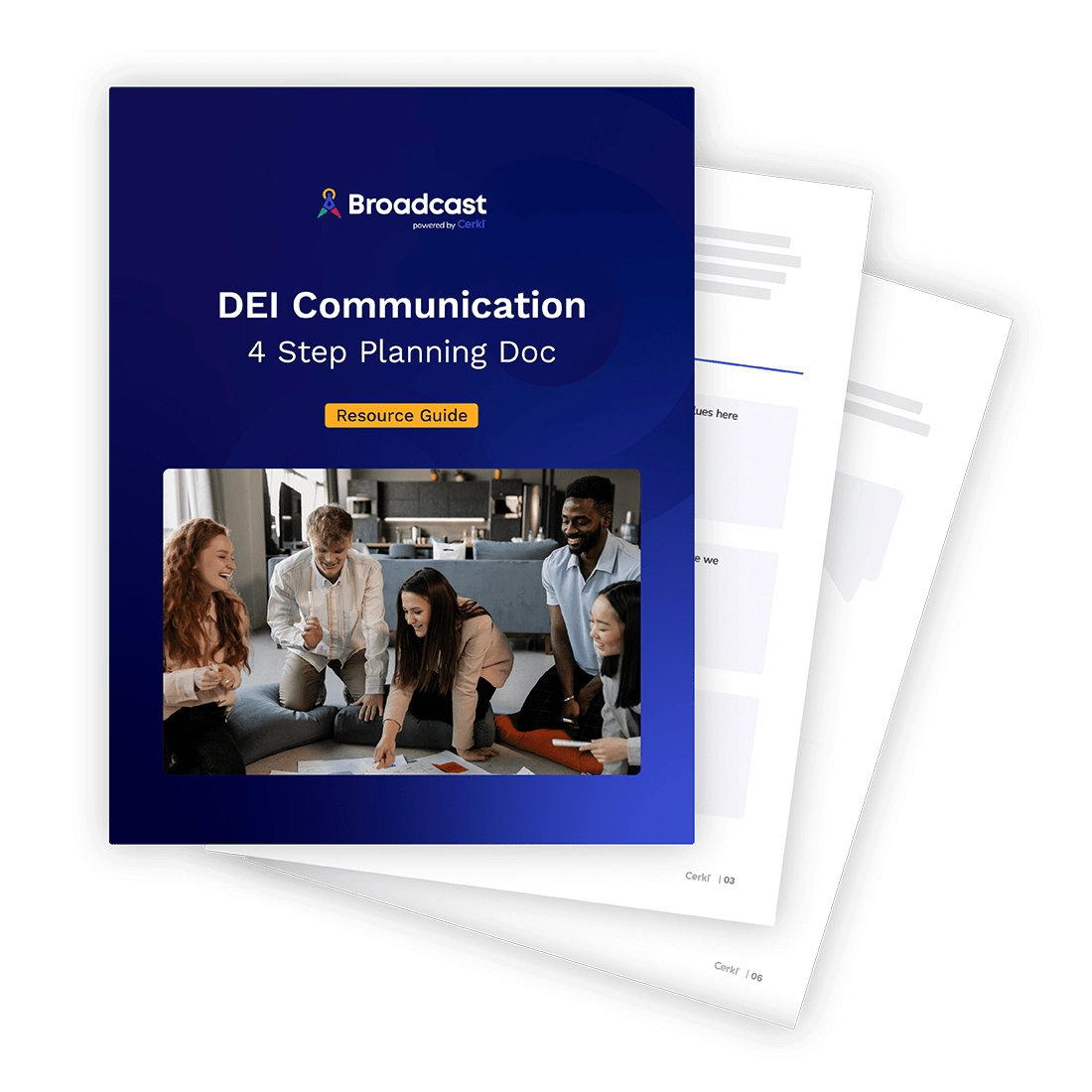
Ensure your company's communications promote diversity, equity, and inclusion
What is a DEI communications strategy? A DEI communications strategy is a plan that outlines how an organization will share its diversity, equity, and inclusion initiatives and progress, both internally and externally. It ensures consistent, transparent messaging that promotes an inclusive workplace culture, engages employees, and aligns with the organization's DEI goals.
How to communicate DEI in the workplace? To communicate DEI in the workplace, organizations should use multiple channels such as internal newsletters, town halls, and employee resource groups to discuss DEI goals, initiatives, and progress. Open forums for feedback and regular updates on DEI efforts can foster transparency and encourage employee participation.
How to use communication strategies to promote equality and diversity? Communication strategies that promote equality and diversity should include inclusive language, representation of diverse voices, and regular engagement on DEI topics. Highlighting diverse success stories, celebrating key awareness days, and providing educational content can help create an inclusive environment where all employees feel valued.
What does a DEI strategist do? A DEI strategist is responsible for developing and implementing strategies that promote diversity, equity, and inclusion within an organization. They analyze current DEI practices, design initiatives to foster a more inclusive workplace, and measure the effectiveness of these efforts to ensure continuous improvement.

Ensure your company's communications promote diversity, equity, and inclusion